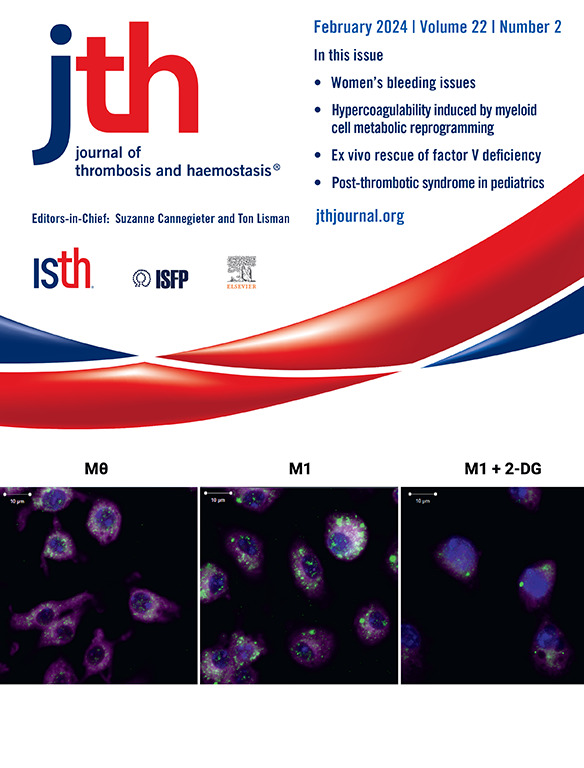Basic regions of factor V and tissue factor pathway inhibitor mediate heavy chain and acidic region interactions on factor V revealed by tethered chemical cleavage
IF 5
2区 医学
Q1 HEMATOLOGY
引用次数: 0
Abstract
Background
Factor (F)V plays a pivotal role in coagulation, having both pro- and anticoagulant functions. Conserved acidic and basic regions (AR and BR) within FVs central B-domain play a key role in regulating procoagulant function. Removing the BR (residues 963-1008) through proteolysis or splicing, as in FV-short, produces an active cofactor, which is partly regulated by tissue factor pathway inhibitor-α (TFPIα) through its C-terminal BR. Although AR2 (residues 1493-1537) is known to be involved, other FV regions that may interact with the FV-BR or TFPIα-BR have not been defined.
Objectives
To uncover binding interactions between the BRs and other regions on FV-short.
Methods
We used a unique chemical cleavage agent, FeBABE (Fe-p-bromoacetamidobenzyl-ethylenediaminetetraacetic acid) tethered to the FV-BR or TFPIα-BR (BR-FeBABE) to footprint areas of engagement with FV-short using biochemical methods and western blotting.
Results
BR-FeBABE bound FV-short and FV-810, another B-domainless form of FV, with high affinity and blocked procoagulant activity, similar to untethered BR. When BR-FeBABE was stimulated, it cut FV-short and FV-810 at 3 sites including the beginning of AR2, near residues 678 to 692 comprising part of AR1 (residues 659-697), and at the beginning of the A2 domain. Cleavage by BR-FeBABE was specific as untethered FV-BR, TFPIα-BR, or TFPIα blocked proteolysis, and forms of FV that do not bind BR-FeBABE, such as FV, FVa, and any form of FV lacking AR2, were not cut.
Conclusion
These results define areas of interaction between the BR and FV-short and advance our knowledge about how FV is regulated by the B-domain and TFPIα.
因子V的碱性区和组织因子通路抑制剂介导重链和酸性区对因子V的相互作用,通过栓系化学裂解揭示。
背景:凝血因子V (FV)具有促凝和抗凝功能,在凝血过程中起着关键作用。FV中心B域内保守的酸性和碱性区域(AR和BR)在促凝血功能的调控中起关键作用。像FV-short一样,通过蛋白水解或剪接去除BR(残基963- 1008),产生一种活性辅因子,其功能部分由组织因子途径抑制剂-α (TFPIα)通过其c端BR调节。虽然涉及AR2(残基1493-1537),但未定义其他可能与FV- br或TFPIα-BR相互作用的FV区域。目的:揭示FV-short上BR和其他区域之间的结合相互作用。方法:采用独特的化学裂解剂FeBABE (Fe-p-bromoacetamidobenzyl- EDTA)拴在FV-BR或TFPIα-BR (BR-FeBABE)上,通过生化方法和western blotting对FV-short接触区域进行印迹。结果:BR- febabe结合FV-short和FV-810(另一种无b结构域形式的FV),具有高亲和力和像未系结BR一样的阻断促凝活性。当BR-FeBABE受到刺激时,它在AR2起始、组成AR1部分的残基678-692附近(残基659-697)和A2结构域起始三个位点切断FV-short和FV-810。BR-FeBABE的切割具有特异性,因为未系结的FV- br、TFPIα- br或TFPIα阻断蛋白水解,不结合BR-FeBABE的FV、FVa和任何缺乏AR2的FV形式都没有被切割。结论:这些研究确定了BR和FV-short之间相互作用的区域,并推进了我们对FV如何受b结构域和TFPIα调节的认识。
本文章由计算机程序翻译,如有差异,请以英文原文为准。
求助全文
约1分钟内获得全文
求助全文
来源期刊
CiteScore
24.30
自引率
3.80%
发文量
321
审稿时长
1 months
期刊介绍:
The Journal of Thrombosis and Haemostasis (JTH) serves as the official journal of the International Society on Thrombosis and Haemostasis. It is dedicated to advancing science related to thrombosis, bleeding disorders, and vascular biology through the dissemination and exchange of information and ideas within the global research community.
Types of Publications:
The journal publishes a variety of content, including:
Original research reports
State-of-the-art reviews
Brief reports
Case reports
Invited commentaries on publications in the Journal
Forum articles
Correspondence
Announcements
Scope of Contributions:
Editors invite contributions from both fundamental and clinical domains. These include:
Basic manuscripts on blood coagulation and fibrinolysis
Studies on proteins and reactions related to thrombosis and haemostasis
Research on blood platelets and their interactions with other biological systems, such as the vessel wall, blood cells, and invading organisms
Clinical manuscripts covering various topics including venous thrombosis, arterial disease, hemophilia, bleeding disorders, and platelet diseases
Clinical manuscripts may encompass etiology, diagnostics, prognosis, prevention, and treatment strategies.

 求助内容:
求助内容: 应助结果提醒方式:
应助结果提醒方式:


